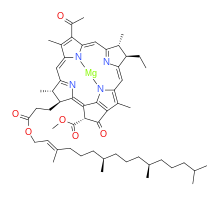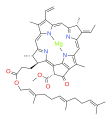
| |
| Names | |
|---|---|
| IUPAC name
[methyl (3S,4S,13R,14R,21R)-9-acetyl-14-ethyl-4,8,13,18-tetramethyl-20-oxo-3-(3-oxo-3-([(2E,7R,11R)-3,7,11,15-tetramethylhexadec-2-en-1-yl]oxy)propyl)-13,14-dihydrophorbine-21-carboxylatato(2−)-kappa4N23,N24,N25,N26]magnesium
| |
| Identifiers | |
3D model (JSmol)
|
|
| ChEBI | |
| ChemSpider | |
| KEGG | |
PubChem CID
|
|
| |
| |
| Properties | |
| MgC55H74N4O6 | |
| Molar mass | 911.524 g·mol−1 |
| Appearance | Light green to blue-green powder |
Except where otherwise noted, data are given for materials in their standard state (at 25 °C [77 °F], 100 kPa).
| |
Bacteriochlorophylls (BChl) are photosynthetic pigments that occur in various phototrophic bacteria. They were discovered by C. B. van Niel in 1932.[1] They are related to chlorophylls, which are the primary pigments in plants, algae, and cyanobacteria. Organisms that contain bacteriochlorophyll conduct photosynthesis to sustain their energy requirements, but the process is anoxygenic and does not produce oxygen as a byproduct. They use wavelengths of light not absorbed by plants or cyanobacteria. Replacement of Mg2+ with protons gives bacteriophaeophytin (BPh), the phaeophytin form.
| Pigment | Taxa | in vivo infrared absorption maximum (nm) |
|---|---|---|
| BChl a | Purple bacteria, Heliobacteria, Green Sulfur Bacteria, Chloroflexota, Chloracidobacterium thermophilum[2] | 805, 830–890 |
| BChl b | Purple bacteria | 835–850, 1020–1040 |
| BChl c | Green sulfur bacteria, Chloroflexota, C. thermophilum,[2] C. tepidum | 745–755 |
| BChl d | Green sulfur bacteria | 705–740 |
| BChl e | Green sulfur bacteria | 719–726 |
| BChl f | (Discovered by mutation of BChl e synthesis by analogy to BChl c/d. Not evolutionarily favorable.)[3] | 700–710 |
| BChl g | Heliobacteria | 670, 788 |
- Structures of major bacteriochlorophylls
-
bacteriochlorophyll a
-
bacteriochlorophyll b
-
bacteriochlorophyll c
-
bacteriochlorophyll d
-
bacteriochlorophyll e
-
bacteriochlorophyll f
-
bacteriochlorophyll g
- ^ Niel, C. B. (1932). "On the morphology and physiology of the purple and green sulphur bacteria". Archiv für Mikrobiologie. 3: 1–112. doi:10.1007/BF00454965. S2CID 19597530.
- ^ a b Bryant DA, et al. (2007-07-27), "Candidatus Chloracidobacterium thermophilum: An Aerobic Phototrophic Acidobacterium", Science, 317 (5837): 523–526, Bibcode:2007Sci...317..523B, doi:10.1126/science.1143236, PMID 17656724, S2CID 20419870
- ^ Vogl K, et al. (2012-08-10). "Bacteriochlorophyll f: properties of chlorosomes containing the "forbidden chlorophyll"". Front. Microbiol. 3: article 298, pages 1–12. doi:10.3389/fmicb.2012.00298. PMC 3415949. PMID 22908012.






